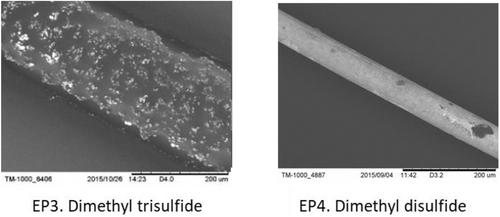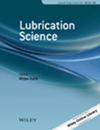用导线腐蚀试验法测定了模型有机硫极压添加剂及其类似物对铜腐蚀的影响
IF 1.8
4区 工程技术
Q3 ENGINEERING, CHEMICAL
引用次数: 1
摘要
采用金属丝腐蚀试验(WCT)研究了模型有机硫极压添加剂和类似物对金属丝腐蚀的影响。从化学结构类型的角度讨论了这些化合物的腐蚀反应。腐蚀速率是根据ASTM G31中的指南计算的,以毫米/年为单位。本文章由计算机程序翻译,如有差异,请以英文原文为准。

The influence of model organosulfur extreme pressure additives and analogues on the corrosion of copper as measured by a wire corrosion test method
A wire corrosion test (WCT) is used to investigate the influence of model organosulfur extreme pressure additives and analogues. The corrosion response from these compounds is discussed with regards to chemical structural type. Corrosion rates were calculated using the guide in ASTM G31 to provide a measurement in mm/year.
求助全文
通过发布文献求助,成功后即可免费获取论文全文。
去求助
来源期刊

Lubrication Science
ENGINEERING, CHEMICAL-ENGINEERING, MECHANICAL
CiteScore
3.60
自引率
10.50%
发文量
61
审稿时长
6.8 months
期刊介绍:
Lubrication Science is devoted to high-quality research which notably advances fundamental and applied aspects of the science and technology related to lubrication. It publishes research articles, short communications and reviews which demonstrate novelty and cutting edge science in the field, aiming to become a key specialised venue for communicating advances in lubrication research and development.
Lubrication is a diverse discipline ranging from lubrication concepts in industrial and automotive engineering, solid-state and gas lubrication, micro & nanolubrication phenomena, to lubrication in biological systems. To investigate these areas the scope of the journal encourages fundamental and application-based studies on:
Synthesis, chemistry and the broader development of high-performing and environmentally adapted lubricants and additives.
State of the art analytical tools and characterisation of lubricants, lubricated surfaces and interfaces.
Solid lubricants, self-lubricating coatings and composites, lubricating nanoparticles.
Gas lubrication.
Extreme-conditions lubrication.
Green-lubrication technology and lubricants.
Tribochemistry and tribocorrosion of environment- and lubricant-interface interactions.
Modelling of lubrication mechanisms and interface phenomena on different scales: from atomic and molecular to mezzo and structural.
Modelling hydrodynamic and thin film lubrication.
All lubrication related aspects of nanotribology.
Surface-lubricant interface interactions and phenomena: wetting, adhesion and adsorption.
Bio-lubrication, bio-lubricants and lubricated biological systems.
Other novel and cutting-edge aspects of lubrication in all lubrication regimes.
 求助内容:
求助内容: 应助结果提醒方式:
应助结果提醒方式:


